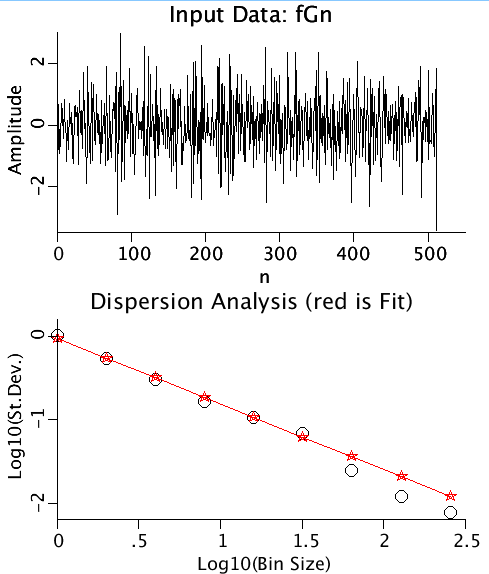Computes the Hurst coefficient for a fractional Gaussian noise series by binning the data (averaging adjacent points) and calculating the standard deviation as a function of bin size.
Description
Dispersion Analysis: Let x(i), i=1,2,...n be a series of n points. Calculate the standard deviation. Next take the numbers in groups (bins) of two and average them (i.e., x2(1)=.5*(x(1)+x(2)), x2(2)=.5*(x(3)+x(4)), ... x2(N/2)= 0.5*(x(N-1)+x(N)). Calculate the standard deviation of this new series. Continue to double the bin size and repeat this process until the bin size reaches n/2. If the OVERLAP option is used, the averages become x2(1)=.5*(x(1)+x(2)), x2(2)=.5*(x(2)+x(3)), ... x2(N/2)= 0.5*(x(N-1)+x(N)). The logarithms of the bin sizes (abscissa) versus the logarithms of the standard deviations is approximately linear, and the slope equals the estimated Hurst coefficient minus 1.0. It is customary to omit the three largest bins from the analysis because they are based on the standard deviations of fewer points: If a series contained 512 points, and the OVERLAP option was turned off the standard deviation for bin size 256 would be based on two points, for bin size 128, 4 points, and for bin size 64, 8 points. The model contains three curves for dispersional analysis, generated by FGP, the fractional Gaussian Process model. The curves were generated with Hurst coefficients of 0.2, 0.5, and 0.7, coresponding to anti-correlated noise, white noise, and correlated noise.

Upper Panel: A time series of Gaussianly distributed random numbers with mean=0, variance=4.
Lower Panel: The autocovariance function (black) and the autocorrelation function (red) are plotted as functions of the lag.
Equations
See Description above.
The equations for this model may be viewed by running the JSim model applet and clicking on the Source tab at the bottom left of JSim's Run Time graphical user interface. The equations are written in JSim's Mathematical Modeling Language (MML). See the Introduction to MML and the MML Reference Manual. Additional documentation for MML can be found by using the search option at the Physiome home page.
- Download JSim model MML code (text):
- Download translated SBML version of model (if available):
- No SBML translation currently available.
- Information on SBML conversion in JSim
We welcome comments and feedback for this model. Please use the button below to send comments:
Please cite https://www.imagwiki.nibib.nih.gov/physiome in any publication for which this software is used and send one reprint to the address given below:
The National Simulation Resource, Director J. B. Bassingthwaighte, Department of Bioengineering, University of Washington, Seattle WA 98195-5061.
Model development and archiving support at https://www.imagwiki.nibib.nih.gov/physiome provided by the following grants: NIH U01HL122199 Analyzing the Cardiac Power Grid, 09/15/2015 - 05/31/2020, NIH/NIBIB BE08407 Software Integration, JSim and SBW 6/1/09-5/31/13; NIH/NHLBI T15 HL88516-01 Modeling for Heart, Lung and Blood: From Cell to Organ, 4/1/07-3/31/11; NSF BES-0506477 Adaptive Multi-Scale Model Simulation, 8/15/05-7/31/08; NIH/NHLBI R01 HL073598 Core 3: 3D Imaging and Computer Modeling of the Respiratory Tract, 9/1/04-8/31/09; as well as prior support from NIH/NCRR P41 RR01243 Simulation Resource in Circulatory Mass Transport and Exchange, 12/1/1980-11/30/01 and NIH/NIBIB R01 EB001973 JSim: A Simulation Analysis Platform, 3/1/02-2/28/07.

